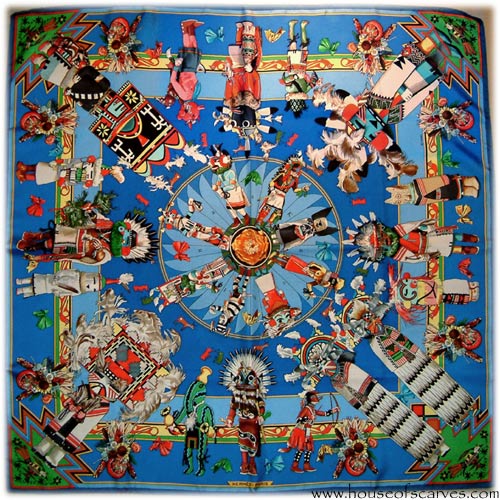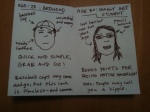With the recent flack about Urban Outfitters and their ‘Navajo’ items, my eye was caught by an image of a silk Hermès scarf when flipping through a magazine the other day. It had a Native American by Kermit Oliver depicted on it (from a plains tribe) and also said “Seattle” on it somewhere to celebrate the recent opening of an Hermès store in the Seattle/Bellevue area. I looked on the website and found their current Native offering, “Cosmogenie Apache,” by European artist Antoine Tzapoff (shown above) currently for sale.
The artwork itself is beautiful, I wouldn’t deny that. But I do question the motives behind selling scarves portraying specific cultures. How is this different from an Indian mascot? Does this celebrate Native people and cultures, or does it demean them? Should all people/cultures be subjected to commercialization? What separates this item from the “Navajo” branded items that Urban Outiftters was selling? (To see more on that topic, check out this post on Native Appropriations blog.)
Apparently, Hermès has a history of creating Native-inspired scarves. Above is “Kachinas” from 1992, also by Kermit Oliver. Again, a beautiful design and scarf. But there is something in it’s existence that makes me uncomfortable. Who is buying these? Why? In my opinion, they seem to fetishize Native Americans and conribute to the presentation of indigenous people as stuck in the past, of being exotic counterparts. How many actual American Indians are purchasing and wearing these scarves at $385 a pop?
Hermès scarves in general, however, are works of art. Read below for a description I found about the making of the “Cosmogenie Apache” scarf:
Most Hermès scarves are designed by illustrators, but recently Pierre-Alexis sought out an artist named Antoine Tzapoff, whose paintings of American Indians he greatly admired. Though Hermès rarely works with artists—they generally use too many colors to reproduce on a scarf—he asked Tzapoff to design one. Tzapoff submitted a stunning portrait of an Apache warrior. Pierre-Alexis fell in love with the painting, called “Cosmogonie Apache,” and sent it to Lyon to have it transformed into a scarf.
When the painting arrived at Marcel Gandit, the 70-year-old silk-engraving company owned by Hermès since 2004, an engraving drawer named Nadine Rabilloud, who has worked there for 33 years, studied it for two days to figure out how to tackle it. Eventually, she identified 80 colors, then edited down to 60, and then to 45—the preferred maximum for the Hermès silk printing process. There are 15 colors for the face alone.
Rabilloud reproduced the face by hand on 90-by-90-centimeter plastic slides with a fountain pen and India ink while two colleagues worked on the background and border. Altogether the trio would spend 2,000 hours reconstructing the painting as a drawing.
Once a design’s slides are completed, each is projected onto a sheet of polyester stretched across a 90-by-90-centimeter steel frame. In the old days, these screens were made of silk pulled tightly across wood frames; later, they were nylon, like that of American parachutes from World War II, on metal frames. The screens are loaded onto an automatic printing machine and are run down 150-meter-long tables—the world’s longest—covered in silk twill. Layer upon layer of color is applied, darkest to lightest. Each color “pass” takes 15 to 20 minutes—the more ink, the more time—so “Cosmogonie Apache,” with its 45 color passes, took approximately 15 hours to print. The silk printing presses run 24 hours, five days a week.
When the ink is dry, the scarves are put in a steam bath to “fix” the colors; washed several times until the fabric is soft; dried; applied with a film fixative to give them a shine and protect the colors; and sent to a workshop where the hems are hand-rolled and hand-stitched. Hermès does 20 new designs a year, 10 for fall-winter and 10 for spring-summer. Each has eight to 10 color variations. Today, a Carré Hermès retails for $385. When the scarves arrive in the shops, they are stored in smart glass cases and dramatically unfurled one after another across countertops by salesclerks for each discerning customer to see, touch and try out. This is yet another tradition that is part of the “culture of Hermès.”
























 This last image didn’t come out well either, but I had wiped up an inkblot that spilled with a paper towel and really liked how it looked on the paper. It was brown ink and the spot is about the size of a dime. Had nice mottling! Cool in a rather abstract way.
This last image didn’t come out well either, but I had wiped up an inkblot that spilled with a paper towel and really liked how it looked on the paper. It was brown ink and the spot is about the size of a dime. Had nice mottling! Cool in a rather abstract way.




